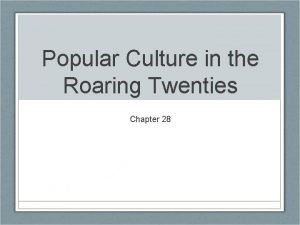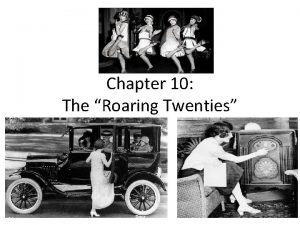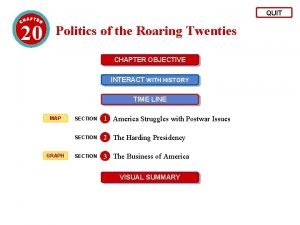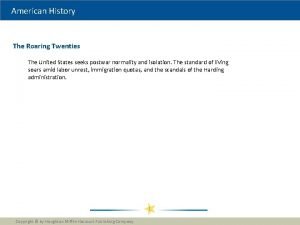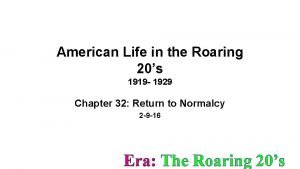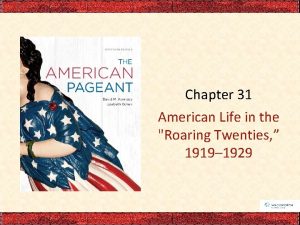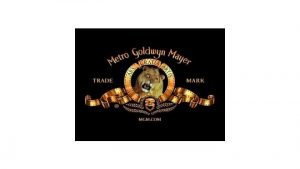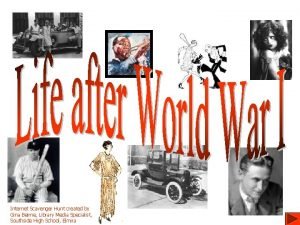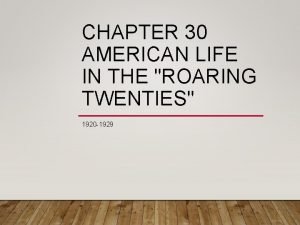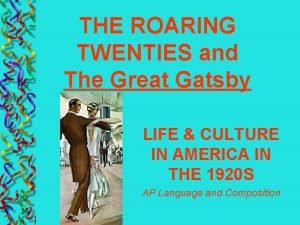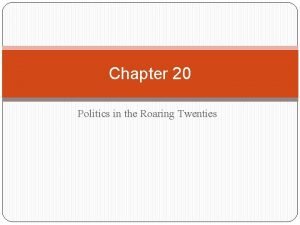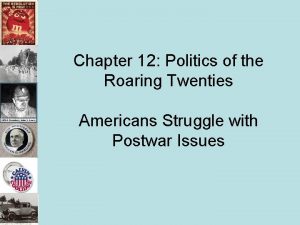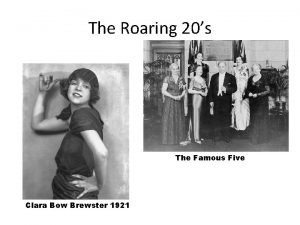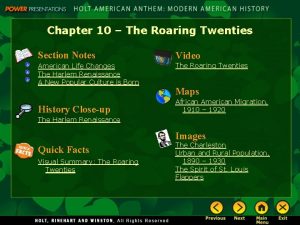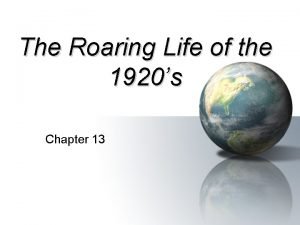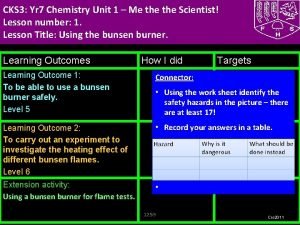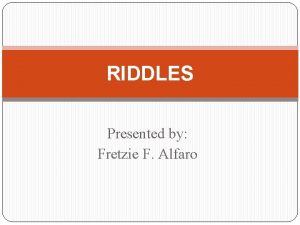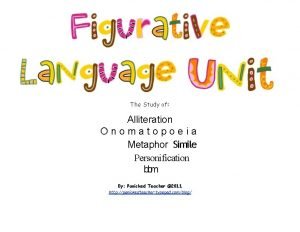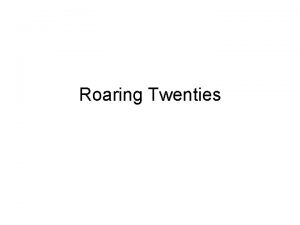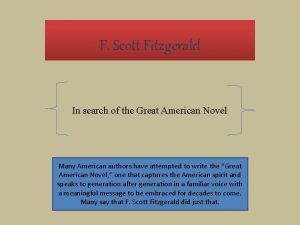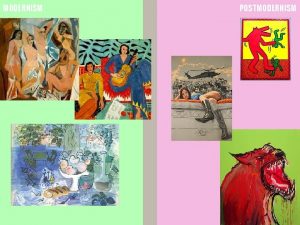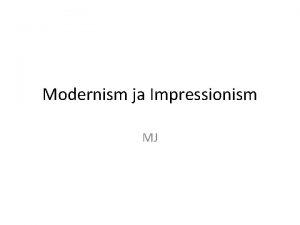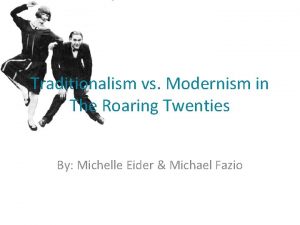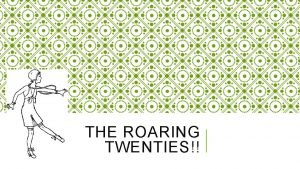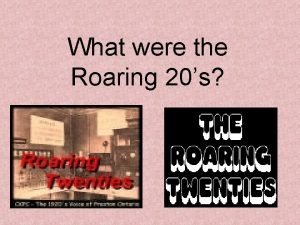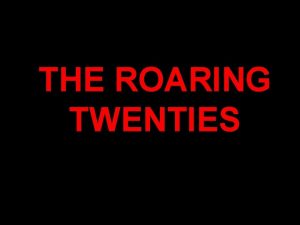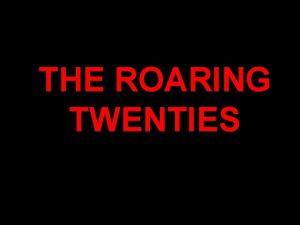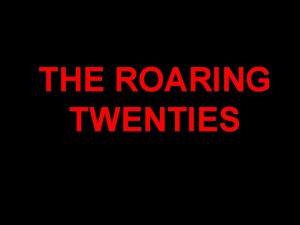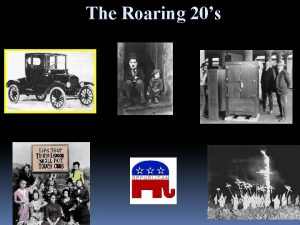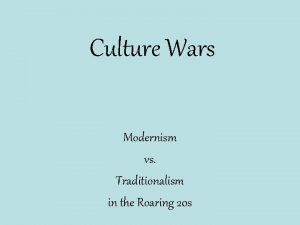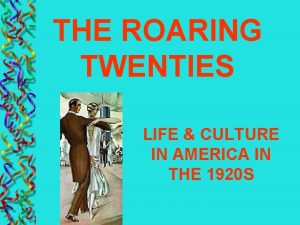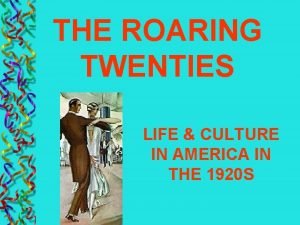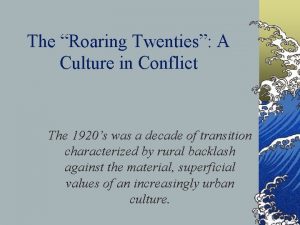The Roaring Twenties A Culture of Modernism Part






















- Slides: 22

The Roaring Twenties A Culture of Modernism Part 1

Learning Objective Today we will describe cultural changes that occurred during the post-war era. What is our learning objective? What will we describe?

Importance Jazz and post-war culture influenced other cultural movements (rock & roll, hip-hop, fashion) The twenties are frequently on the AP exam, MC, DBQ & FRQ. Why is this subject important?

Importance - DBQ The 1920’s were a period of tension between new and changing attitudes on the one hand traditional values and nostalgia on the other. What led to the tension between old and new AND in what ways was the tension manifested?

APK - Rebellion

APK - Comparison The Gibson Girl Flapper A/B: Compare and contrast the two styles. Why did this cultural digression occur?

The Roaring Twenties Post-war prosperity and rebellion from societal norms caused a major cultural change within the United States. The 1920 census reported that for the first time, more than half of the American people lived in urban areas. The culture of the cities was based on popular tastes, morals and habits of mass consumption that were increasingly at odds with strict religious codes of rural America. A. Define: the Roaring Twenties. B. What caused this cultural shift.

Economic Conditions Signs of Prosperity: During the 1920 s the standard of living rose, more people moved to urban areas. Larger numbers of women & men working in office jobs Greater emphasis on the marketing of consumer goods. Growing investment in the stock market. Ford’s assembly line enabled many Americans to purchase automobiles. Signs of Trouble Farmers experienced less favorable conditions, caused by falling prices and unforeseen circumstances. A. What caused post-war prosperity? B. Who was most hurt financially during this time period? Why?

The Culture of Modernism The Arts The “Lost Generation of the 1920 s” Writers like Sinclair Lewis, F. Scott Fitzgerald, Earnest Hemingway, T. S. Elliot, Ezra Pound These artists and writers scorned religion, and condemned war sacrifices, that were perpetuated by money. They criticized middle-class materialism and conformity. Jazz Created by African-American musicians like Joe King Oliver and Jelly Roll Morton. Symbolized the desire to break away from tradition. The use of phonographs and radios made this available to the public. A. What is the “Lost Generation”? B. How did music during the ‘ 20 s reflect cultural changes in society?

Consumer Economy

Entertainment The radio became the new medium for entertainment and communication. The movie industry centered around Hollywood became a big business. Stars like Greta Garbo and Rudolf Valentino were idolized. “Talkies” – sound pictures were introduced in 1927, with the movie, the Jazz Singer. A. Describe the major change in entertainment. B. How did the motion picture industry affect women during the twenties?

Celebrities Babe Ruth &Ty Cobb Charles Lindbergh The Spirit of St. Louis Jack Dempsey

Gender Roles, Family & Education 19 th Amendment – passed in 1920, although voting patterns showed that women followed party preferences of the men in their families. Women in the labor force remained generally the same. Morals The most significant change was the revolt against sexual taboos. Some were influenced by Freud, who stressed the role of sexual repression in mental illness. Movies, music, novels and dance steps encouraged promiscuity. Although birth control was against the law in almost every state, Margaret Sanger achieved acceptance in the twenties. Fashion Influenced by actors and desire for independence, “flappers” shocked the older generation. A. Who is Margaret Sanger? B. How did the role of women change during the ’ 20 s?

Religion Modernism Protestants sought to redefine their faith by taking a historical and critical view of passages of the bible. Many accepted Darwin’s theory of evolution. Fundamentalism Preachers in rural areas condemned modernists and interpreted the Bible in a literal fashion. Rejected evolution and preached creationism. Revivalists Used new forms of communication to spread fundamentalist ideals. Evangelists like Billy Sunday and Aimee Semple Mc. Pherson attacked drinking, jazz and the evils of communism. A. How is modernism different from fundamentalism? B. How did new technology help spread fundamentalist ideas?

Art Edward Hopper Critical view of urban life Georgia O'Keefe Stark & feminine Frank Lloyd Wright Functionalism A. How does art during the 1920 s reflect major cultural changes?

The Harlem Renaissance Harlem became famous in the 1920 s for its concentration of talented actors, artists, musicians and writers. Poets and Musicians Their poems were about African-American heritage, that expressed bitterness, joy and resentment. Countee Cullen, Langston Hughes, Claude Mc. Kay. Marcus Garvey A charismatic Jamaican immigrant who advocated individual and racial pride for African Americans. Garvey established the United Negro Improvement Association, that worked towards racial separatism, economic self-sufficiency and the back-to-Africa movement. A. Describe the Harlem Renaissance. B. Who is Marcus Garvey? What did he inspire in the 1960 s?

MC Question 1 All of the following were notable trends and movements in the 1920 s EXCEPT: A. increase in union membership B. increase in productivity C. urbanization D. consumerism E. business prosperity

MC Question 2 During the 1920 s, the group who generally did NOT prosper were A. owners of small businesses B. farmers C. Wall Street Brokers D. professionals E. residents of western cities

MC Question 3 Margaret Sanger was most closely associated with which of the following issues or movements? A. Birth control. B. Women's rights. Civil Rights. D. Prohibition. E. Labor unions.

MC Question 4 Who was the charismatic political leader of the United Negro Improvement Association who eventually ended up being deported back to his Jamaican homeland for mail-fraud of his own people? A. Langston Hughes. B. Andrew W. Mellon. C. Joseph King Oliver. D. Al Jolson. E. Marcus Garvey

Learning Objective - Closure Today we will describe cultural changes that occurred during the post-war era. Without looking at your notes, list and describe 3 major cultural changes that occurred during the post-war era.

Document File Assignment With your partner you will work to sort and analyze the documents in your file. First, with your partner work to complete the column titled: Description & Big Cheeses. Only complete the topics that we have covered in class today. Next, read through all of the documents within your packet. Sort each document and put it in the appropriate topic. Once all documents have been analyzed, interpret the historical importance of each document. What does it reveal about this time period?
 Chapter 28 popular culture in the roaring twenties
Chapter 28 popular culture in the roaring twenties Chapter 10 the roaring twenties
Chapter 10 the roaring twenties Politics of the roaring twenties
Politics of the roaring twenties The roaring twenties lesson 3 changing ways of life
The roaring twenties lesson 3 changing ways of life Roaring twenties acrostic poem
Roaring twenties acrostic poem Chapter 31 american life in the roaring twenties
Chapter 31 american life in the roaring twenties The roaring twenties canada
The roaring twenties canada Five effects of the great depression
Five effects of the great depression Chapter 30 american life in the roaring twenties
Chapter 30 american life in the roaring twenties Roaring 20s were characterized by
Roaring 20s were characterized by Roaring twenties great gatsby
Roaring twenties great gatsby Chapter 20 politics of the roaring twenties
Chapter 20 politics of the roaring twenties Politics of the roaring twenties chapter 12
Politics of the roaring twenties chapter 12 Roaring twenties acrostic poem
Roaring twenties acrostic poem Chapter 20 politics of the roaring twenties
Chapter 20 politics of the roaring twenties Chapter 10 the roaring twenties answer key
Chapter 10 the roaring twenties answer key Chapter 13 the roaring life of the 1920s
Chapter 13 the roaring life of the 1920s Roaring flame bunsen burner
Roaring flame bunsen burner Romeo and juliet act 4 scene 1
Romeo and juliet act 4 scene 1 Riddle me riddle me here comes a roaring chain
Riddle me riddle me here comes a roaring chain Personification definition with examples
Personification definition with examples Demobilization roaring 20s
Demobilization roaring 20s The roaring 20’s / jazz age
The roaring 20’s / jazz age
